7.2 Embankments and Structural Fills
Localized failures of railroad and road embankments occurred throughout the region. In many instances these failures appeared to be directly related to liquefaction of the foundation soil, but more traditional slope failures were also evident. Figure 7.8 shows a typical failure of an embankment above railroad tracks. The slope was initially supported by a low wall, which is now being replaced by a driven steel pile wall. This method of repair was extensively used by the railroads in the wake of the earthquake.
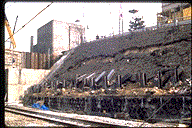 Figure 7.8: Failure of an embankment above railroad tracks in Kobe.
Figure 7.8: Failure of an embankment above railroad tracks in Kobe.
Evidence of downhill extension and displacement of structural fills and stone retaining walls was particularly evident in parts of residential developments extending into the hills. The incidence of these failures seemed to be highest along the extension of the strike of the faulting, and typically involved sidehill fills for roads and residential lots. The fills appeared to be composed of compacted decomposed granite, which is relatively coarse with little apparent cohesion. The deformation of the fills caused displacement and cracking of pavements and retaining walls (Figure 7.9), and in at least one location a road embankment essentially failed leaving the road unservicable (Figure 7.10). The damage to some of the residential lots is illustrated in (Figure 7.11), showing deep extension cracks running parallel to the slope contours. The failures of the fills appeared to be the result of a combination of inadequate compaction and inadequate keying into the bedrock, and the retaining walls lacked adequate capacity to resist seismic loading (Figure 7.12). In addition to structural damage, these failures broke underground utilities, disrupting gas, sewer, and water service to entire neighbourhoods.
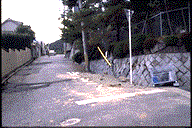 Figure 7.9: Pavement deformation and damage to rock retaining wall caused by seismically induced deformation of sidehill fill.
Figure 7.9: Pavement deformation and damage to rock retaining wall caused by seismically induced deformation of sidehill fill.
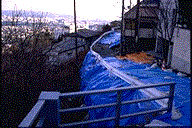 Figure 7.10: A road fill settled and moved laterally several meters.
Figure 7.10: A road fill settled and moved laterally several meters.
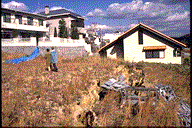 Figure 7.11: Deep tension cracks in a sidehill fill on a residential lot. Note the separation in the rock retaining wall in the background. This type of damage was typical in this neighborhood.
Figure 7.11: Deep tension cracks in a sidehill fill on a residential lot. Note the separation in the rock retaining wall in the background. This type of damage was typical in this neighborhood.
 Figure 7.12: Typical failure of a stone retaining wall in a residential area.
Figure 7.12: Typical failure of a stone retaining wall in a residential area.
In comparison to the residential construction, many large retaining structures for major roads and railways seemed to perform much better. Figures 7.13 and 7.14 show two fairly substantial retaining walls which performed well and showed no apparent signs of distress.
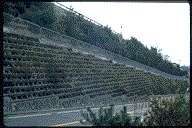 Figure 7.13: Undamaged crib retaining structure in Ashiya.
Figure 7.13: Undamaged crib retaining structure in Ashiya.
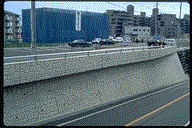 Figure 7.14: Undamaged reinforced earth wall supporting a roadway in Ashiya.
Figure 7.14: Undamaged reinforced earth wall supporting a roadway in Ashiya.